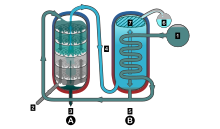Column still

A column still, also called a continuous still, patent still or Coffey still, is a variety of still consisting of two columns invented in 1826 by Robert Stein, a Clackmannanshire distiller and first used at the Cameron Bridge Grain Distillery. The design was enhanced and patented in 1831 by an Irishman, Aeneas Coffey. The first column (called the analyser) has steam rising and wash descending through several levels. The second column (called the rectifier) carries the alcohol from the wash where it circulates until it can condense at the required strength.
Column stills behave like a series of single pot stills, formed in a long vertical tube. The tube is filled with either porous packing or bubble plates. The rising vapor, which is low in alcohol, starts to condense in the cooler, higher level of the column. The temperature of each successively higher stage is slightly lower than the previous stage, so the vapor in equilibrium with the liquid at each stage is progressively more enriched with alcohol. Whereas a single pot still charged with wine might yield a vapor enriched to 40-50% alcohol, a column still can achieve a vapor alcohol content of 96%; an azeotropic mixture of alcohol and water. Further enrichment is only possible by absorbing the remaining water using other means, such as hydrophilic chemicals or azeotropic distillation.
A column still is an example of a fractional distillation, in that it yields a narrow fraction of the distillable components. This technique is frequently employed in chemical synthesis; in this case, the component of the still responsible for the separation is a fractionating column.
A continuous still can, as its name suggests, sustain a constant process of distillation. This, along with the higher concentration of alcohol in the final distillate, is its main advantage over a pot still, which can only work in batches. Continuous stills are charged with pre-heated feed liquor at some point in the column. Heat (usually in the form of steam) is supplied to the base of the column. Stripped (alcohol-free) liquid is drawn off at the base, while almost pure alcohol is condensed after migrating to the top of the column. The disadvantage of a continuous still, at least for the production of alcohol, is that the alcohol produced is not rendered free of lower-boiling-point contaminants (such as methanol and acetaldehyde).
Column stills are frequently used in the production of grain whisky. Distillation by column still is the only permissible method for production of Armagnac, while use of column stills for the related Cognac is forbidden.
